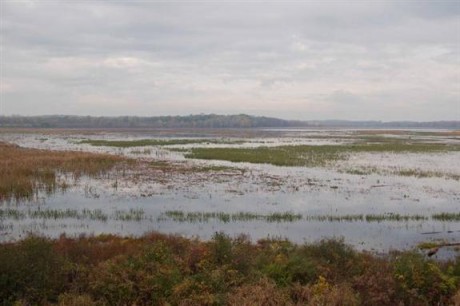
Northern Montezuma Marsh Wetland. The wetland complex has more than 18,000 acres of marshes, wooded swamps, small ponds and streams–Wetlands provide the perfect habitat for waterfowl and other migratory birds.
Naturally occurring wetlands form when rain and runoff from watersheds saturate the ground or there is a continual flow of groundwater to the surface. Flood waters and coastal waters that immerse low-lying land near waterways can also cause a natural wetland to form.
Some people may confuse watersheds with wetlands. The primary difference between a wetland and a watershed is that water runs off a watershed into various waterways, such as streams or creeks. The water eventually makes its way to larger bodies of water, such as lakes and oceans. A wetland collects the water between the watershed and the body of water. It acts as a filter to remove pollutants before the water collects in rivers and streams. A wetland always maintains a certain amount of water. However, a watershed becomes dry after the water runs off. [source: USGS]
Wetlands play an integral role in the ecology of the watershed. The combination of shallow water, high levels of nutrients, and primary productivity is ideal for the development of organisms that form the base of the food web and feed many species of fish, amphibians, shellfish, and insects.

Third Creek entering into Sodus Bay. Wetlands directly improve other ecosystems. A wetland has many cleansing benefits and have been compared to kidneys. The analogy is good one. Wetlands and kidneys both help control water flow and cleanse the system.
Many species of birds and mammals rely on wetlands for food, water, and shelter, especially during migration and breeding.
Ways wetlands help the environment:
- Flood and Storm Water Control
- Surface and Groundwater Protection
- Erosion Control
- Pollution Treatment and Nutrient Cycling
- Fish and Wildlife Habitat
Resources:
